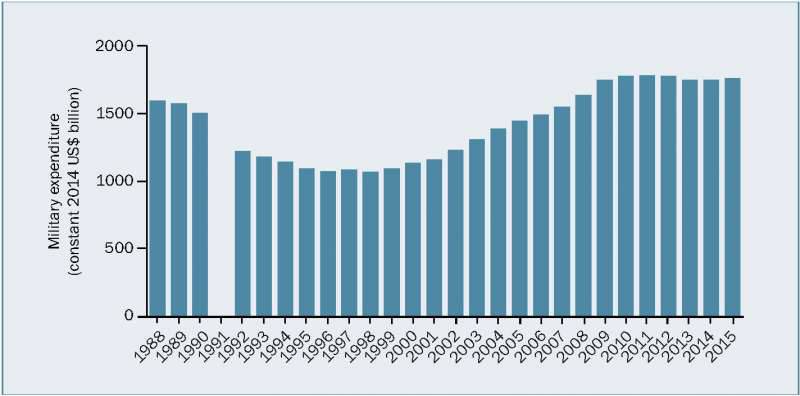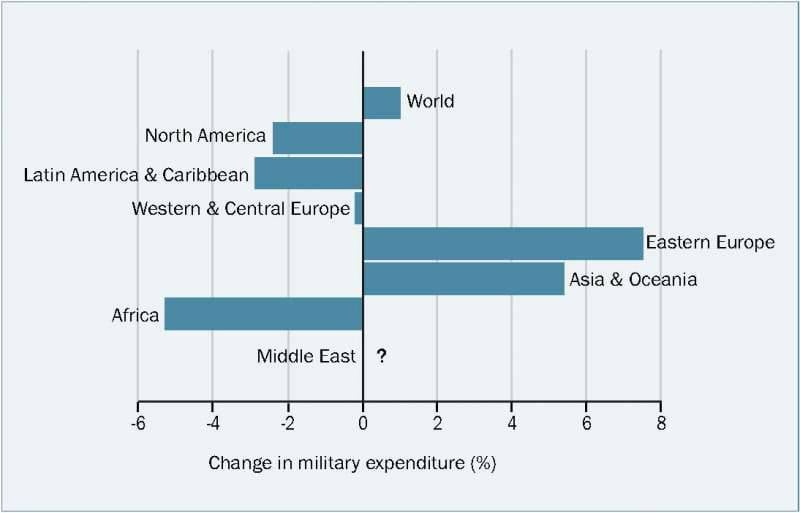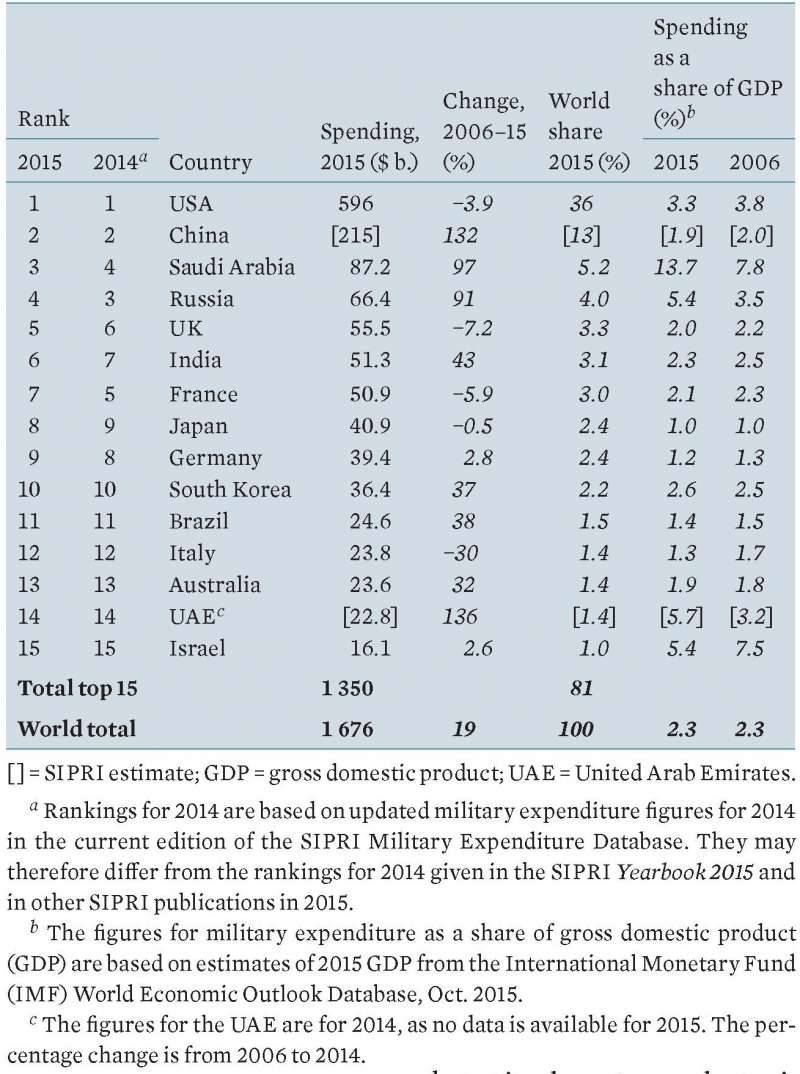SIPRI Global Defense Spending Report published
General trends
Traditionally, all the major trends observed in this area and contained in the report are made by SIPRI employees in a press release accompanying the publication of the main document. First of all, in the accompanying article it is noted that the total volume of military expenditures of the world in 2015 amounted to 1676 billions of US dollars. In comparison with the previous year, 2014 costs increased by 1%. Thus, for the first time since 2011, the market is not declining, but growing. The increase in global indicators contributes to increased costs in Asia and Oceania, in Central and Eastern Europe, as well as in some Middle Eastern countries. At the same time, the rate of reduction of expenditures of Western states is gradually decreasing, while Africa, Latin America and the Caribbean are forced to cut funding for armies. As a result, the picture in the international market is complex and heterogeneous.
SIPRI officials point out that the current situation on the energy market has a significant impact on military spending. In the recent past, high oil prices and the development of new fields have contributed to increased defense spending in many countries. In 2014, energy prices began to fall sharply, forcing some countries, depending on their sales, to revise their budgets. Similar problems have already led to a reduction in military spending in some countries, and this trend is likely to continue in the 2016 year.
The fall in oil prices hit hardest the military budgets of Venezuela (-64%) and Angola (-42%). The military spending of Bahrain, Brunei, Chad, Ecuador, Kazakhstan, Oman and South Sudan also suffered. Other exporting countries such as Algeria, Azerbaijan, Russia, Saudi Arabia and Vietnam continued to increase their military budgets, despite the problems with the prices of important export goods.
Since 2009, there has been a steady decline in military spending in the countries of North America, as well as in Western and Central Europe. The main reasons for this are the financial crisis and the withdrawal of most of the international contingent from Afghanistan and Iraq. In 2015, there were signs of a cessation of similar phenomena and future cost increases. For example, the US military budget for 2015 was reduced by only 2,4% compared to the previous year. Currently, Congress is trying to protect the defense budget from further cuts, which leads to the corresponding results.
The overall performance of Western and Central Europe in 2015 fell by only 0,2%. At the same time, there is a noticeable growth in Eastern Europe: the states are concerned about the Ukrainian crisis and are taking certain measures in case of further deterioration of the situation in the region. Western European countries, in turn, reduced their costs by 1,3%, but this was the smallest reduction since 2010. In the future, the region may again begin to increase its budgets.
SIPRi analysts note that the situation with military spending in the coming years is not predictable. The increase in spending in recent years has been beneficially affected by the increasing complexity of the international situation and the growth of tension in some regions. In addition, the growth of budgets was provided by an increase in energy prices. In the current situation with the persistence of threats and falling oil prices, further events in the world are extremely difficult to predict.
Leaders on spending
Traditionally, the SIPRI report presents a ranking of countries that occupy a leading position in the world in terms of military spending. In this "Top 15" there are leading countries with the largest economies that can afford large expenditures on defense. Interestingly, in the 2014-15 years, the list of 15 leaders remained almost unchanged: eight states retained their places in the ranking, while the others shifted by no more than one or two lines.
That year in a row the United States retains the first place in military spending. In 2015, the Pentagon was allocated 596 billion dollars, representing 36% of the total global expenditures. Compared to 2006, the year the US military budget fell by 3,9%, but this did not prevent the United States to maintain a significant lead over its closest pursuers and stay at the top of the ranking.
The second place, as in 2014, was taken by China. According to experts of the Stockholm Institute (open data on this account are not available, which is why analysts have to use approximate estimates), last year the Chinese military spent 215 billion US dollars or 13% of global spending. In comparison with 2006, an increase is observed at the level of 132%.
The top three in the last year was Saudi Arabia, which rose one line up. Its military budget in 2015 was equal to 87,2 billion dollars - 5,2% of the costs of the whole world. Over the past ten years, Arabian defense spending increased by 97%.
The latest achievement of Saudi Arabia led to the fact that in 2015, Russia dropped from third to fourth place. With a defense budget of 66,4 billion, our country accounts for 4% of total global spending. At the same time, with 2006, spending increased by 91%.
At the end of the top five was Great Britain, which rose from one year to 2014. Interestingly, since 2006, it has reduced its military budget by 7,2%, but at the same time it is 55,5 billion dollars (3,3% of the world total) and allows it to occupy a rather high position in the ranking.
The remaining places in the top ten are occupied by India (moved up from seventh to sixth), France (dropped from fifth to seventh), Japan (moved up one rank from ninth place), Germany (swapped with Japan) and South Korea (left for 10- m). Outside the dozens of leaders remained Brazil, Italy, Australia, the United Arab Emirates and Israel. From 10 to 15, inclusive, the “Top 15” last year did not change. All permutations touched only his first ten.
The total spending of 15 leaders in current rankings last year amounted to 1350 billion US dollars. This is 81% of global spending. Compared to 2006, the performance of the 15 Top Index increased by 19%. It should be noted that during this period the list of 15 leaders in military spending has changed significantly, so that the comparison of indicators is carried out solely on the total amounts.
Records of growth and decline
An important element of the SIPRI report is information on the growth and reduction of budgets of individual countries. In 2006-15, a number of countries showed a uniquely high increase in defense spending and equally high cuts. It is necessary to take into account that in some cases there is a start from very low indicators, which facilitate the setting of records in percentage terms. Nevertheless, in this case, such ratings are of interest and demonstrate interesting trends.
The undisputed leader in the growth of the military budget in the last ten years has been Iraq. Last year, its defense expenditures amounted to 13,12 billion dollars, an increase of a record 2006% from 536 year. In this case, the reason for the emergence of such large numbers were the problems associated with the restoration of the country after the war and the change of power. The gradual improvement of the situation, and then the terrorist threat, forced official Baghdad to dramatically increase military spending.
The second highest growth rate was the Gambia, with a military budget of 12,5 billion and 380-percent increase in 2006-15. Three leaders closes the Republic of Congo. Despite a modest budget of 705 million, this country shows an increase of 287%. The growth of the Argentinean budget for the same period is estimated at 240% (with a budget for 2015 a year at 5,475 billion), and Ghana, spending only 180 million last year, increased spending by 227%.
As noted in a press release to the report, the fall in oil prices seriously hit the budget expenditures of several countries. So, in the case of Venezuela, such events led to a record reduction in the defense budget. In 2015, Venezuelan defense spending declined by 64% compared to 2014, and in the period from 2006 to 2015, the reduction was 77%. This brings the country to the first place in the anti-record rating.
Slovenia and Latvia share the second and third places, cutting budgets by 37%. At the same time, 2015 million dollars remained at the disposal of the Slovenian military in 407, while the Latvian received only 286. The top five in terms of reductions are closed by Greece and the Czech Republic, which were forced to cut military budgets by 35%. After that, Greece was able to allocate billion dollars to the needs of the 5,083 army, and the Czech Republic - 1,778 billion.
Regional Indicators
Asia and Oceania continue to show strong growth rates. In 2014-15, it was 5,4%, and since 2006, an 64-percent increase has been achieved. The total costs of countries in the region are estimated at 436 billion. Almost half of these costs fall on China, the remaining 51% is shared by several dozens of other states.
Europe as a whole, without division into smaller regions, shows not very outstanding results. In total, last year, European budgets grew by 1,7% compared to 2014 and amounted to 328 billion dollars. Over a ten-year period, they grew by only 5,4%. Most European spending (253 billion) falls on the countries of Western and Central Europe. Eastern European states, in turn, spent only 74,4 billion. At the same time, the annual growth of expenses amounted to 7,5%, and from 2006, budgets increased by 90%.
The assessment of the Middle East’s indicators was hampered by the lack of data on the budgets of some countries. SIPRI analysts failed to obtain verified information about Kuwait, Qatar, Syria, the United Arab Emirates and Yemen. For this reason, only Saudi Arabia, Iraq and Iran were taken into account in the calculations. Over the past year, these countries have spent a total of X billion dollars on their armies. Growth in comparison with the previous year was 110,6%.
Overall Latin American and Caribbean figures fell by 2,9% to 67 billion. Despite this, the growth in comparison with the 2006 indicators of the year is 33%. The costs of South American countries amounted to 57,6 billion dollars - minus 4% compared to 2014 year, but 27% more than 2006-th. Central America and the Caribbean spent only 9,5 billion, with an annual increase of 3,7% and a ten-year increase of 84%.
Africa has reduced total defense spending to 37 billion dollars or by 2,3% relative to 2014 of the year. Despite this, growth in 2006-15 years remains at an optimistic level of 68%. North Africa has increased its spending by 2,1% for the year and by 68% for ten years, bringing them to the level of 17,9 billion dollars. Indicators of Central and Southern Africa, in turn, have fallen markedly. With a total expenditure of 19,1 billion, the reduction in 2014-15 was 11%. In relation to the 2006 indicators of the year, growth remained at the level of 30%. The main reason for the fall in Central and Southern Africa was the 42-percent reduction in Angola’s military budget, caused by falling oil prices.
***
The current situation with the defense budgets of various countries is very interesting. After several years of continually reducing the overall performance of the whole world, there has been a slight increase. At the same time, the budgets of some countries continue to decline, while other states, on the contrary, are increasing their spending. Against the background of these events, new local conflicts occur and new threats arise that can affect the further development of strategies. According to specialists from the Stockholm Institute for World Studies, there is now another factor that has a serious impact on the policies and economies of states - falling energy prices.
As a result of all current events, various states have to act in accordance with the requirements of the time, and also to take into account the existing restrictions. The current situation is so complex that it is almost impossible to predict. However, it should be monitored and one or other conclusions drawn. That is what SIPRI is currently doing. In the near future, this organization should release a new report, revealing other details of the current situation in the field of development of armies and arms sales.
Press release:
http://sipri.org/media/pressreleases/2016/milex-apr-2016
Full report:
http://books.sipri.org/files/FS/SIPRIFS1604.pdf



Information